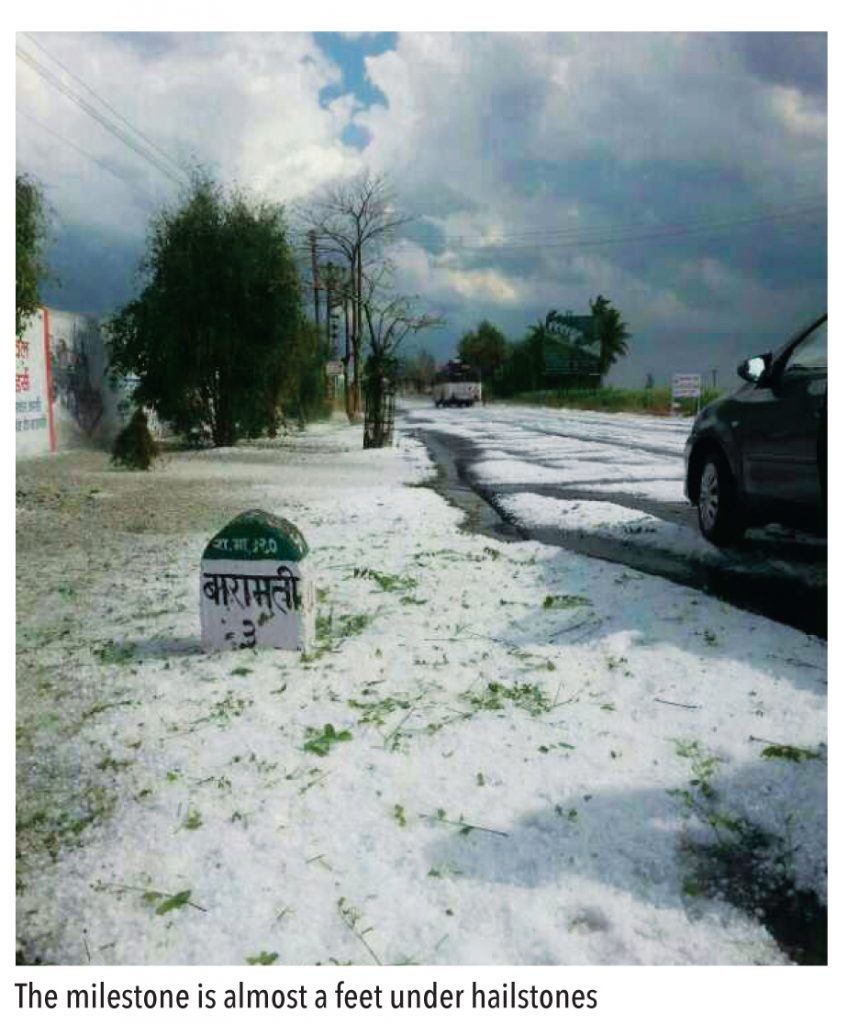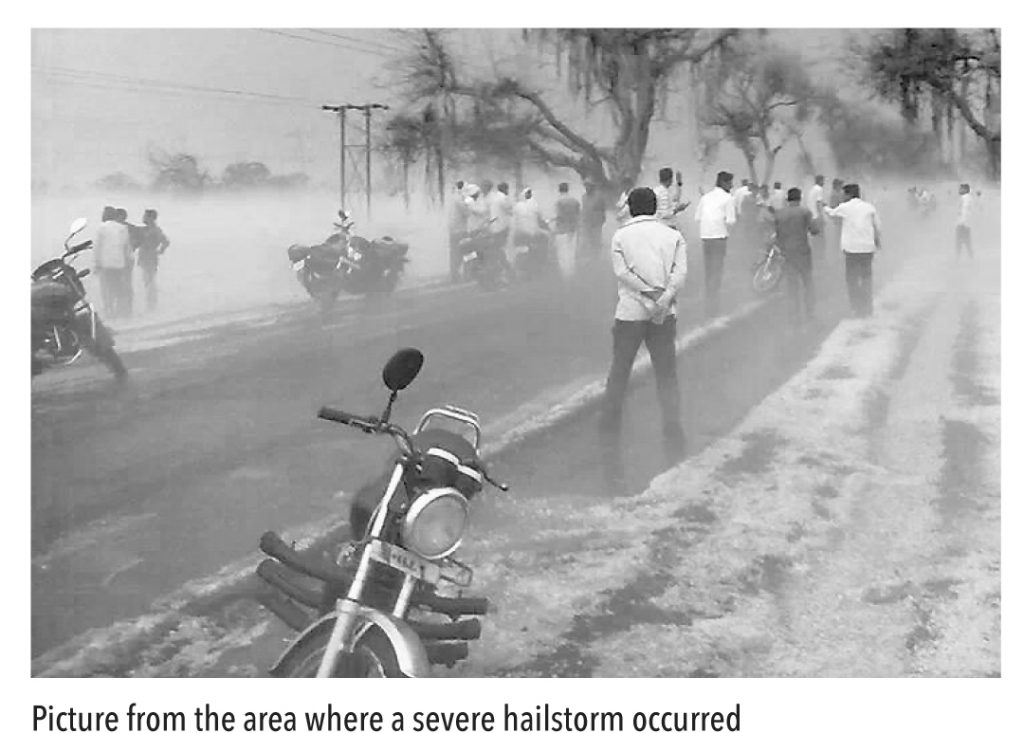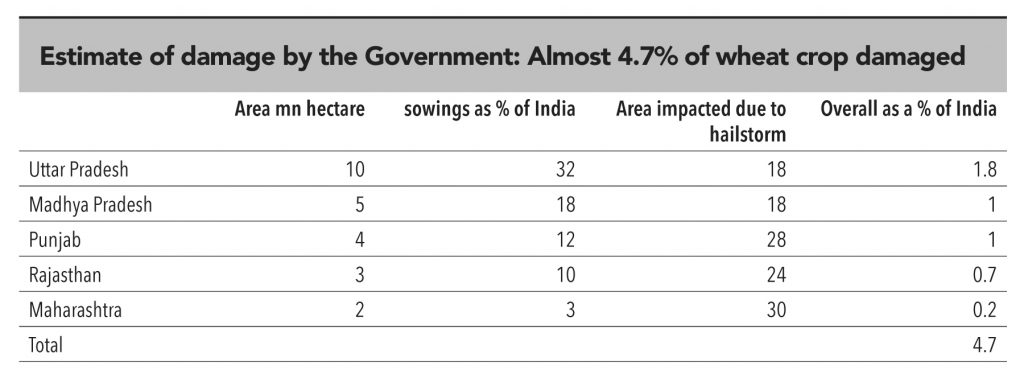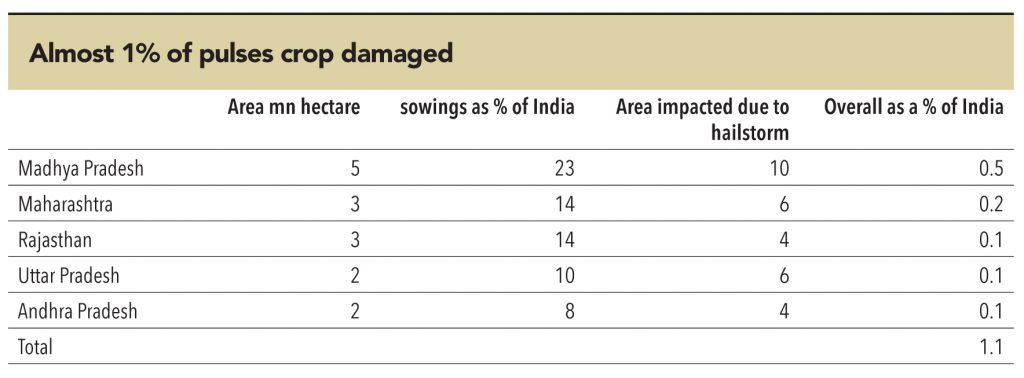Of all the states, Maharashtra has been the worst affected due to the recent and unexpected hailstorm and heavy rains. To get first-hand feedback and assess the damage to agri produce and the affected areas, Ground Zero spoke to a few farmers and representatives — the situation seems grave in some areas and normal in others; the discrepancy seems to exist because rains and hailstorms have been scattered and inconsistent.
Our take
Crops in many areas are affected in terms of yield and quality. Fruits and wheat in particular are affected in most areas as the timing of harvest matched the hailstorm and rains. Thus, despite good monsoon across the state in H1FY14, the late rains have unbalanced the equation for agriculturist.While supply of fruits and wheat will be curtailed, the quality of pulses and vegetables is likely to be affected, and the sowing pattern for next year might be disturbed.
We spoke to farmers in UP (Agra), Western Maharashtra (Sangli), MP (Indore), Marathawada (Parli) and visited a few farmers in Vidarbha (Akola and Amravati). What we gather is that the rain was totally unexpected and abrupt and thus gave no chance to farmers to prepare any defense (such as early removal or processing of the produce or covering whatever is standing in the fields).
A Sangli-based farmer, who is also a leader of the farmers movement, told us that fruit plantation suffered large damage and to some extent the sugarcane crop. A large area near Pune (especially near Baramati) suffered heavily. These places are high-yield capital-intensive farming areas, thus the damage is material in value terms. Most farmers are not keen on the one-time aid for such damage but want structurally higher prices for farm output.
In Marathwada, we gathered from a farmer (who grows vegetables (mainly ladies’ finger) and supplies it to Pune and Mumbai daily) that the story remains the same — most of the damage was suffered by fruit/horticulture farmers while the regular cash crops (pulses/cotton or even vegetables) were partly affected. This particular farmer was not as aggrieved, since his crop is little affected (his produce is plucked on a daily basis as vegetables have a shorter shelf life). However, he did say that some pomegranate plantations in the area had suffered. He claimed that many orchards around his farm would have suffered damage to the extent of Rs2000,000-4000,000 (quite sizable!).


In Vidarbha (eastern-most part of Maharashtra), the rains and hailstorm did create havoc with damage to orange farmers and short-cycle crops such as pulses, soya bean, etc. In many parts of the region orange and sweet lime were destroyed — the yield is reduced to abysmally low levels and the quality of the fruits saved is poor. A visit to a few farms and farmers in Amravati and Akola district revealed that largely the chana (Bengal gram, the 2nd crop of the season) crop was affected. In many places, the yield had fallen to almost nil from the usual 8-10 quintals (800-1,000kgs) per acre. When this rain occurred most non-irrigated farms were through with one crop (typically soya bean, cotton first yield, tuvar (yellow pigeons pea), etc.). Fortunately, this first crop has been remunerative in terms of yield and prices.
The Indore farmer was not as unhappy with the weather gods because even though his main crop (wheat) did see some yields erosion (largely indicative for the entire Malwa region), he was happy with the pricing scenario.
An Agra farmer shared that the main crop damaged was potato and according to him the area surrounding Agra, which is primarily a potato sowing region, could see a yield drop of approximately 20-40%. His view was that in Punjab the loss in potato was close to 50%. But that said, farmers don’t seem to have too much of margin losses, as lower yields are compensated by higher prices. Even for most of the sarson (mustard) and wheat, the crop had ripened and was saved before the weather turned unfavourable.
It’s interesting to hear the farmers belief — “Jahan ghata hua hai, wahan agle saal munafa Hoga” “Whatever losses we have suffered this year, we will make up next year” — their mentality is to not immediately jump to the next crop if there is a loss one year.
In most of the places that we surveyed, the main damage was to longer-cycle crops such as fruits (papaya, grapes and pomegranate), sugarcane, and vegetables while the cash crops or the short-cycle crops such as pulses, oil seeds, and proteins were not subject to large scale damage.
Blessings in disguise — cotton yields rise, fed by the late rains
In some areas in Vidarbha the hailstorm and late rains have had a favorable effect particularly for the cotton plantation, with yields rising by almost 20-40%. Typically, cotton yields 6-15 quintals (600-1,500kgs) per acre (average range for the past few years). The hailstorm came after the end of the final plucking of cotton (2nd yield) with most places yielding an average 8-10 quintals (800-1,000kgs) per acre. With the incremental rain, the existing cotton plants flourished giving an additional yield of 2-5 quintals (200-500kgs) per acre. Moreover, cotton prices at the mandis (markets) are around Rs 5,000/quintal (which are higher than the past few years’ MSP of around Rs 4000/quintal).


However, this unexpected bounty may also pose a different problem for the upcoming sowing season — it might marginally delay farm preparation and thus sowing in some cases.
Since the weather events occurred just before voting, most political parties, especially the local leaders, demanded compensation for the damage ranging from Rs 20,000 to Rs 100,000 per acre. However, the reality remains that the farmers want structurally higher prices for their produce rather than one-time help from the government. The state government did announce some packages to the farmers in proportion to their estimate of the damage in specific areas.
What should one expect the trend in FY15 to be?
Cotton acreage is likely to increase at the cost of soya bean and other crops (mainly pulses). Not many farmers are fully aware and concerned about the strong possibility of El Nino in this season (June-Sept 2014) and the likely adverse impact. The met department has not issued an explicit El Nino warning yet, but a strong EL Nino might derail the agriculture projections for the country.
Stronger El Nino, higher impact
As per our weather expert, World Weather Inc, an impressive warming in the subsurface of the eastern Pacific Ocean is under way. An upwelling current is expected to bring the warm water to the surface of the ocean within the next few weeks to initiate the transition to El Nino conditions. The impact will bring changes in weather around the world with drought in Indonesia, Malaysia, and eastern Australia high on the list of potential impacts during the Northern Hemisphere’s mid to late spring and summer.
Recent sea surface temperatures in the tropical equatorial Pacific Ocean have been cooler than usual. The cool conditions have given the impression that ocean temperatures were trending more toward a La Nina event than an El Nino. But significant changes below the surface of the ocean are telling a completely different tale. The transition from neutral ENSO conditions to an El Nino event is expected to occur over a relatively short period of time (AprilMay).
Some of the scientists are expecting 2014 El Nino to be worse than the record El Nino event of 1997-98, when food grain output for India declined by 3.6% and agri GDP by 2.6%. Assuming El Nino starts in May-June, impact on Indian weather will be in the form of below average rainfall and precipitation.
We looked at the rainfall, food production, and food inflation data during the years El Nino affected India. We saw that medium-strong El Nino substantially impacted foodgrain output and food inflation while a weak El Nino’s impact was muted. However, unseasonal rainfall has already hurt India’s rabi output and food inflation has remained high despite good monsoon in the last few years. Thus, a bout of poor rainfall and agricultural output may seriously worsen food inflation.
Subscribe to enjoy uninterrupted access